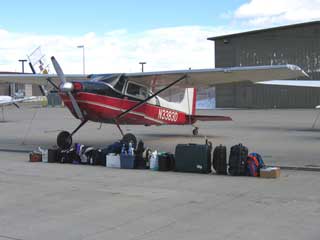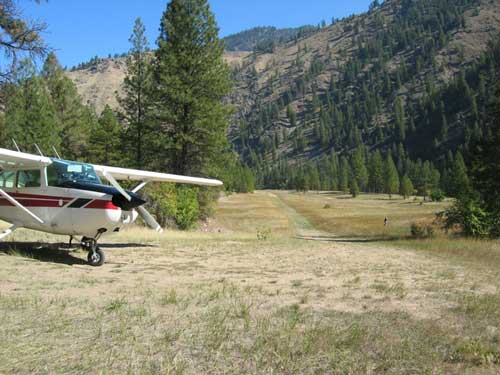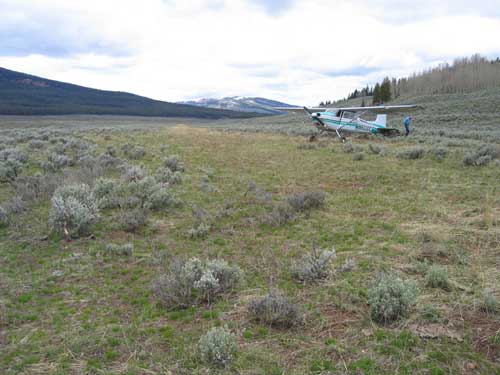Indian Summer Complacency
During the last days of summer there is often a possibility of a stretch of good weather, called Indian summer, that leads complacent pilots to experience problems with density altitude.
 Definition
Definition
Operation at an airport with high elevation, hot temperature, and high humidity will likely raise the “performance altitude” of the airplane, often by thousands of feet, resulting in decreased aircraft performance.
Density altitude, by official definition, is the pressure altitude corrected for non-standard temperature variation. It relates to the takeoff and climb performance of the airplane. In this vein it is an expression of the thickness of the air, or lack of thickness. A high density altitude means thin air. Thin air reduces the lift of the wings, the thrust of the propeller and the power output of the engine.
I like my definition of density altitude better. Density altitude is the altitude the airplane “thinks” it is at and performs in accordance with. An airplane operating at sea level with standard conditions will experience a density altitude of sea level. But add a low-pressure area and temperatures well above standard and the sea level operation may be the equivalent of a 4,000-foot density altitude. In this case, even though the airplane is at sea level, it performs as if it were flying at 4,000 feet during standard conditions.
It is often necessary to off-load some baggage to
be able to operate at high density altitude airports.
Aircraft Performance
When a pilot is exposed to a high density altitude operation, it becomes the pilot’s responsibility to determine that the airplane has the required performance to make the takeoff and then out climb any obstructions or terrain during the transition to the en route phase of flight.

Rule of thumb to determine density altitude:
For each 10-degrees Fahrenheit above (or below) standard temperature for an airport’s elevation, add (or subtract) 600 feet to (from) the field’s elevation.
Standard temperature at sea level is 59-degrees F. Subtract 3.5 degrees per 1,000-feet elevation above sea level to determine standard temperature. For example, at an airport at 6,000-feet elevation, multiply 3.5 times 6 for 21. Subtract 21 from 59 to find the standard temperature at a 6,000-foot airport is 38º F.
If the temperature is 80 degrees, subtract 80 – 38 = 42, about 4 10-degree intervals. Multiply 4 times 600 for 2,400. Add 2,400 to the elevation (6,000) for a density altitude of 8,400 feet. Although the physical altitude is 6,000 feet, the airplane will perform as if it is operating at a standard day at 8,400 feet.
Obtaining a value for the density altitude doesn't particularly help the pilot unless he looks at the owner's manual of pilots operating handbook to find the effect on performance. The DENALT Performance Computer provides a factor for applying to the sea level takeoff distance and sea level rate of climb to determine anticipated performance under density altitude conditions.
A Cessna 172 (180 horsepower) at Idaho's Wilson
Bar airstrip may require
delaying the takeoff until the temperature cools.
Performance Limitations
An airplane with a fixed-pitch propeller, like the Cessna 172, suffers performance deterioration from a high density altitude. Generally you can use the Owner’s Manual or Pilots Operating Handbook to determine the sea level takeoff distance. Then, based on the density altitude, add to this takeoff distance a value of 12 percent for each 1,000 feet up to 8,000 feet; and, add 20 percent for each additional 1,000 feet density altitude above 8,000 feet.
The constant-speed (variable pitch) propeller airplane, like the Cessna 180, suffers less than the fixed-pitch prop airplane, but it still experiences a significant deterioration in performance. Here, add 10 percent for each 1,000-feet density altitude up to 8,000 feet. Add 15 percent for each 1,000-feet density altitude above 8,000 feet.
Other Factors
Density altitude is a good gauge of the performance you may expect from your airplane. Keep in mind some other factors that require consideration: gross weight, wind, runway surface, gradient, aircraft and engine condition and the pilot’s skill.
 Complacency
with density altitude has no place at the Kinky Creek Divide
airstrip located about 38-nautical miles east of Jackson, Wyoming.
Aircraft performance is degraded due to the 8,838-foot MSL
elevation.
Complacency
with density altitude has no place at the Kinky Creek Divide
airstrip located about 38-nautical miles east of Jackson, Wyoming.
Aircraft performance is degraded due to the 8,838-foot MSL
elevation.
Dealing with the Takeoff
A rule of thumb that becomes invaluable for density altitude operations describes the runway length requirement. If you have doubts as to whether the runway is long enough for takeoff, walk the length of the runway and mark the half-way point in some manner; maybe a high-visibility streamer on a stick or a pile of rocks.
During the takeoff if 70 percent of the speed necessary for takeoff is obtained by the half-way point of the runway, there will be sufficient runway to continue the takeoff. If you don’t have 70-percent takeoff speed, abort and wait until conditions are more favorable (cooler temperature, head wind, or off-load some weight).
Don’t let complacency spoil your Indian summer adventure.
|
|
|

